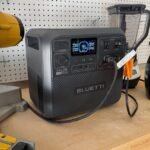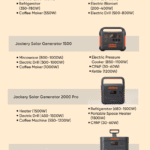Disclosure: This post contains affiliate links and I will be compensated if you make a purchase after clicking through my links. Learn More
A generator getting wet can be a serious problem. Water and electricity don’t mix well.
If your generator gets wet, it’s important to act quickly and safely. Generators are vital during power outages. They keep essential appliances running and provide comfort. However, exposure to water can damage the generator or even pose safety risks. Understanding what steps to take can save your equipment and prevent accidents.
In this post, we’ll explore practical actions you can take if your generator gets wet. Whether it’s due to unexpected rain or flooding, these tips will guide you through the process of safeguarding your generator and ensuring it continues to serve you effectively. Stay tuned to learn how to handle this situation properly.
Immediate Actions
Generators are essential, especially during power outages. But what do you do if your generator gets wet? Taking immediate action is crucial to ensure safety and prevent damage. Below are some immediate actions you need to take.
Disconnect Power
First, disconnect the generator from any power sources. Doing this prevents any electrical hazards. Water and electricity don’t mix. Disconnecting the power ensures safety for you and your equipment.
Move To Dry Area
Next, move the generator to a dry area. A dry spot will help in drying out the generator faster. Make sure the area is well-ventilated. This will prevent any moisture buildup, which can cause further damage.
Assess Damage
If your generator gets wet, the first step is to assess the damage. Water can cause serious issues. Identifying them early can save time and money. Take a careful approach. This will help you decide the next steps.
Check For Visible Issues
Start by examining the generator for any visible issues. Look for rust or corrosion. These are clear signs of water damage. Check the fuel tank. Ensure no water has seeped in. Inspect the wires. Wet wires can be dangerous. Also, look at the air filter. A wet air filter can block airflow.
Listen For Unusual Sounds
Turn on the generator briefly. Listen carefully. Any unusual sounds indicate a problem. Grinding noises may mean internal damage. Sputtering could be a sign of water in the fuel. If you hear anything strange, turn off the generator immediately. This prevents further damage.
Drying Techniques
Generators can get wet due to rain or spills. Shut off the generator immediately and dry it thoroughly before use. Using a dry cloth or air dryer can help ensure safety and prevent damage.
When your generator gets wet, it’s crucial to dry it thoroughly before using it again. Improper drying can lead to damage and safety hazards. Let’s explore some effective drying techniques to restore your generator to working condition.
Use Towels
First, grab a few clean, dry towels. Use them to wipe down the exterior of the generator.
Pay special attention to vents and any openings where water might have seeped in.
Keep drying until you’re confident that the exterior is moisture-free. Towels are great for absorbing water quickly and efficiently.
Employ Fans
Fans can be extremely useful for drying your generator. Set up a couple of fans around the generator, ensuring they cover all sides.
This will help evaporate any remaining moisture inside.
Leave the fans running for several hours, or until you’re sure the generator is completely dry.
A personal tip: once my generator got soaked during a storm. Using towels followed by fans worked wonders. I didn’t face any issues after that.
Ever wondered why drying is crucial? Water can cause electrical shorts, leading to expensive repairs or worse, accidents. So, it’s best to be thorough.
What’s your go-to method for drying devices? Share your thoughts below!

Credit: outbax.com.au
Inspect Components
Generators are essential during power outages. But they can be vulnerable to water damage. If your generator gets wet, it’s crucial to inspect its components. Doing this can prevent further damage and ensure safety. Below are key areas to examine.
Examine Fuel System
Water in the fuel system can cause serious problems. Start by checking the fuel tank. Look for signs of water contamination. Water can mix with fuel and cause engine issues. Drain the fuel tank if needed. Replace it with fresh fuel. Also, inspect the fuel lines and filters. Make sure they are dry and clean. Wet fuel lines can lead to rust and blockages.
Check Electrical Connections
Wet electrical connections can be dangerous. They can cause short circuits or corrosion. First, turn off the generator and disconnect it from any power source. Inspect all electrical connections carefully. Look for signs of moisture or rust. Dry them thoroughly before reconnecting.
Use a dry cloth or a hairdryer on a low setting. If the connections are severely corroded, replace them. Ensure all connections are secure and dry before restarting the generator.
Preventive Measures
Generators are crucial during power outages. Keeping them dry is essential. Wet generators can malfunction or become dangerous. Here are preventive measures to keep your generator safe.
Use Covers
Covers protect generators from rain and moisture. Choose a durable, waterproof cover. Ensure it fits your generator snugly. A tight fit prevents water from seeping in.
Inspect covers regularly for wear and tear. Replace them if damaged. Proper covers prolong the generator’s lifespan. They also prevent corrosion and rust.
Elevate Generator
Elevation keeps generators above ground moisture. Place the generator on a sturdy platform. Avoid direct contact with the ground. Elevated generators stay dry during heavy rainfall.
Ensure the platform is stable and level. This prevents tipping and accidents. Elevated generators also have better airflow. This reduces overheating and improves efficiency.
Professional Help
Seek professional help if your generator gets wet to avoid damage. Experts can safely assess and repair any issues.
Professional Help
When your generator gets wet, it can be a stressful situation. Sometimes, the best option is to seek professional help. Technicians have the expertise to diagnose and fix the issue safely and efficiently.
When To Call A Technician
You might wonder when it’s necessary to call in a professional. If your generator has been submerged in water or shows signs of significant water damage, it’s time to call a technician. Attempting to start a wet generator can be dangerous and may cause further damage.
If you notice unusual noises or smoke, these are red flags. A technician can identify and resolve these issues before they escalate.
Cost Considerations
Hiring a professional does come with a cost. However, it’s a worthwhile investment to avoid potential hazards and further damage. The cost can vary based on the extent of the damage and the technician’s expertise.
For minor repairs, you might spend less. However, extensive water damage could result in higher costs. It’s helpful to get a few quotes to ensure you’re getting a fair price.
Have you ever tried to fix an appliance only to make it worse? Sometimes, spending a bit upfront can save you money and headaches in the long run.
Professional help ensures your generator is safe and operational. Don’t wait until it’s too late—call a technician when in doubt.
Restarting Safely
Your generator got wet. Now what? Restarting it safely is crucial. Wet generators can be hazardous if not handled properly. Here’s how you can restart your generator safely.
Test In Controlled Environment
Before you attempt to restart your generator, make sure you are in a controlled environment.
Choose a dry, open space with good ventilation. This reduces the risk of fumes building up. It’s also easier to handle any unexpected issues.
Keep a fire extinguisher nearby. Safety first! You never know when you might need it.
Monitor Performance
Once you’ve restarted the generator, keep an eye on its performance.
Check for unusual sounds, smells, or vibrations. These could be signs of internal damage. If you notice anything off, turn it off immediately.
Observe the generator’s power output. Is it running smoothly? Consistent power is a good sign. If the power fluctuates, you might need professional help.
Restarting a wet generator can be nerve-wracking. Have you ever faced a similar challenge? How did you manage? Share your story in the comments below!

Credit: www.angi.com
Long-term Maintenance
Long-term maintenance of your generator is crucial, especially if it gets wet. Proper care ensures longevity and optimal performance. Here are some essential steps for long-term maintenance.
Regular Inspections
Conduct regular inspections to detect any damage or wear. Check for rust and corrosion, especially if the generator has been exposed to moisture. Inspect all electrical connections and make sure they are tight and clean. Look for any signs of water damage or dirt buildup on the generator’s components.
Test the generator periodically to ensure it starts and runs smoothly. Listen for unusual noises or vibrations which could indicate a problem. Keep a log of your inspections and any maintenance work performed. This helps track the generator’s condition and schedule future maintenance.
Proper Storage
Store your generator in a dry, clean place to prevent moisture damage. Use a cover to protect it from dust and dirt. Ensure there is adequate ventilation to avoid overheating. If storing for a long period, drain the fuel to prevent it from degrading and damaging the engine.
Before storing, clean the generator thoroughly. Remove any dirt, grime, or debris from the exterior and interior parts. This helps maintain its condition and ensures it is ready for use when needed. Consider using a dehumidifier in the storage area to reduce moisture levels.
Frequently Asked Questions
Will A Generator Get Ruined If It Gets Wet?
Yes, a generator can get ruined if it gets wet. Moisture can damage the electrical components. Always keep your generator dry and protected from rain.
How To Dry A Wet Generator?
To dry a wet generator, first turn off the power. Remove any water and moisture using a towel. Use a hairdryer on a low setting or place the generator in a warm, dry area. Ensure complete drying before restarting.
What To Do If Water Enters Your Generator?
Turn off the generator immediately. Disconnect it from the power source. Allow it to dry completely. Check for damage. Consult a professional for repair or inspection.
Can I Cover My Generator With A Tarp?
Yes, you can cover your generator with a tarp. Ensure it has proper ventilation and is not running.
Final Words
Keep your generator dry to ensure safety. Wet generators can cause damage. Turn off the generator immediately if it gets wet. Move it to a dry place. Let it dry completely before use. Regular maintenance prevents future issues. Safety comes first.
Follow these steps to protect your investment. A well-maintained generator lasts longer. Stay safe and prepared.








